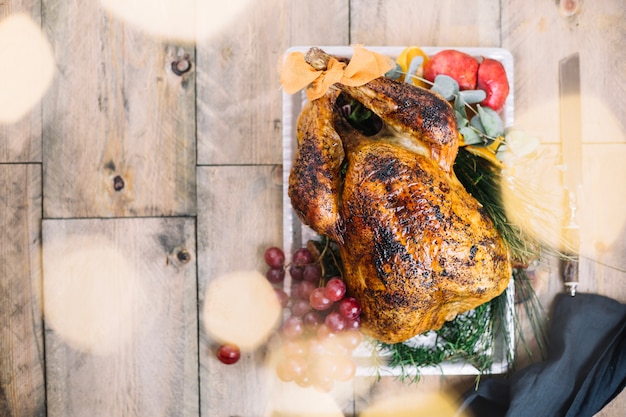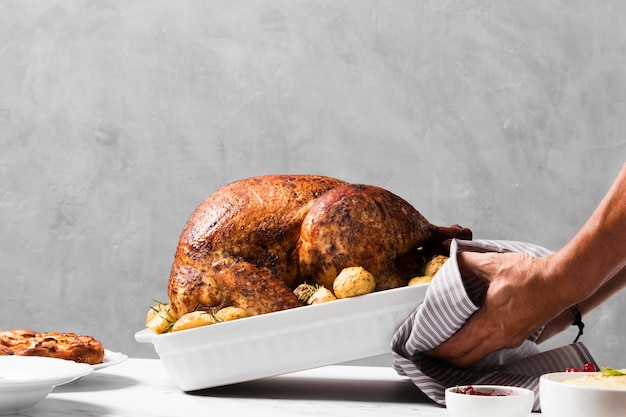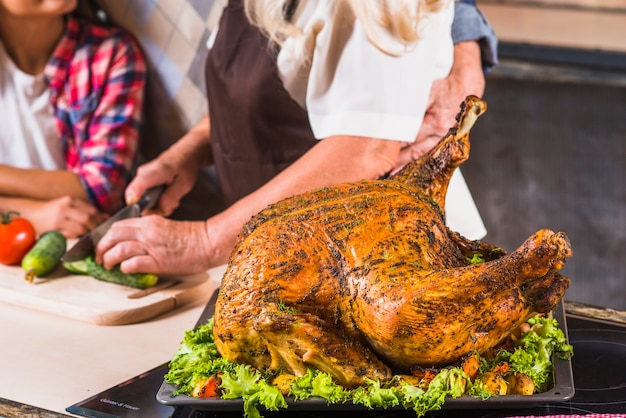(Part 1) Choosing the Right Turkey

Size Matters
First things first, consider the size. A good rule of thumb is about 1 pound of turkey per person. So, if you're feeding 6 people, a 6-7 pound turkey should be just right. Now, don't be tempted to go for a smaller bird to save space in the fridge. Remember, a smaller bird will cook faster, so you might end up with a dry turkey.The Type of Turkey: Traditional or Adventurous
Now, what kind of turkey do you want? I'm a traditionalist, nothing beats a good old-fashioned free-range bird. The flavour is richer, and the meat is just a little bit more succulent. But if you're feeling adventurous, there's always a bronze turkey, which is a bit more intense in flavour, or a heritage breed for a real gourmet experience.Picking the Perfect Bird
No matter what type of turkey you choose, make sure it feels firm and springy to the touch. The skin should be free of any bruising or tears, and the legs should be plump. If you're buying a frozen turkey, make sure it's fully thawed before you start cooking.(Part 2) Preparing Your Turkey

Giblets and Neck: Don't Throw Them Away
The first thing you need to do is remove the giblets and neck from the cavity. Now, don't throw them away! You can use them to make a delicious gravy later on.Pat It Dry for a crispy skin
Next, pat the turkey dry with kitchen paper. This is crucial for a crispy skin. The moisture on the skin will prevent it from browning nicely.Butter and Herbs: A Flavor Boost
Now, for the flavour boost. I like to rub the turkey with a mixture of butter and herbs. It's simple, but oh so effective! You could use fresh herbs like rosemary, thyme, and sage, or go for a ready-made blend of herbs and spices. Experiment and find your favourite combination!Stuffing: Moist and Flavorful
If you're stuffing your turkey, do this before you pop it into the roasting tin. But don't overstuff it. You want the stuffing to be cooked through but not overly dense. A little tip from my grandma: If you're using a dry stuffing, moisten it with a little chicken stock before filling the cavity. It helps it cook evenly and stay juicy.(Part 3) Getting Ready to Roast

Choosing the Right Tin
Choose a roasting tin that's large enough for your turkey to sit comfortably. You don't want it crammed in there! You can even use a roasting rack if you want. This helps the air circulate around the bird and ensures even cooking.Liquid for Moisture and Flavor
Now, you need a good splash of liquid in the bottom of the tin. This helps keep the turkey moist and adds a delicious flavour to the gravy. You can use chicken stock, water, or even white wine. Personally, I like to use a mixture of stock and white wine. It gives the gravy a bit more oomph!(Part 4) The Big Roast
Okay, the big moment is here.Oven Temperature: Steady and Consistent
Pop your turkey into the preheated oven at 325°F (160°C). Now, for the magic part, the roasting time. It's not just about sticking it in for a set amount of time. It's about ensuring it's cooked through.Roasting Time: The Per Pound Formula
The size of your turkey determines the roasting time. But there's a handy formula to follow, and it's always saved my bacon (or should I say, turkey!):Roast Time per Pound:| turkey weight (lbs) | Roasting Time (minutes) |
|---|---|
| 8-12 lbs | 15-20 minutes per pound |
| 12-16 lbs | 18-20 minutes per pound |
| 16-20 lbs | 20-25 minutes per pound |
Checking for Doneness: The meat thermometer
Now, keep an eye on that beautiful bird. It's important to ensure it's cooked through. You can check the temperature using a meat thermometer. Stick it into the thickest part of the thigh, not touching the bone. It should register 165°F (74°C) for a juicy and safe turkey.Basting: The Secret to Moisture
Don't forget to baste your turkey every 30-45 minutes. This helps keep the skin moist and prevents it from drying out. You can use the pan drippings or a mixture of butter, herbs, and stock for basting.(Part 5) The Resting Game
Okay, so the turkey is cooked, and you're ready to carve it. Hold your horses! This is where resting comes in. It's a crucial step that often gets overlooked, but it makes a world of difference!Let It Rest: Juices Redistribute
Let the turkey rest for 15-20 minutes before carving. During this time, the juices redistribute themselves throughout the meat, making it even more tender and succulent.Carve Later: Prevent Dry Turkey
If you carve it right away, those juices will run out, leaving your turkey dry. So, be patient, let the turkey rest, and you'll be rewarded with a more delicious and juicy bird.Make Gravy While It Rests
While the turkey is resting, you can prepare the gravy. Use the pan drippings and the juices from the turkey to make a delicious gravy. Just don't forget to skim off any excess fat from the pan drippings before you start making the gravy.(Part 6) Carving the Bird
Alright, the turkey has rested, the gravy is ready, it's finally time to carve!A Sharp Knife: Essential for Clean Slices
This is where your carving skills come in. If you're not a carving pro, don't worry, it's easier than it looks. Just use a sharp carving knife and be patient.Carving Steps: Breasts, Legs, and Wings
Start by carving the breasts. Hold the turkey steady and slice through the breastbone. Then, gently remove the breasts from the bone. You can slice the breasts into thin slices or leave them whole, depending on your preference. Next, carve the legs. Cut through the joint between the thigh and drumstick. Then, use the carving knife to separate the leg from the thigh. You can then slice the thigh and drumstick into smaller pieces. Finally, carve the wings. Cut through the joint between the wing and the body. Then, remove the wings from the bone. You can either slice the wings into smaller pieces or leave them whole.(Part 7) Serving Up the Feast
Now, the moment of truth. It's time to serve up your delicious, perfectly roasted turkey.Plating Perfection: Turkey, Sides, and Gravy
Arrange the carved turkey on a platter, surround it with your favourite side dishes, and pour yourself a glass of something festive.Don't Forget the Gravy: The Perfect Complement
And don't forget the gravy! A good gravy is the perfect complement to a roast turkey. Pour it generously over the turkey and side dishes.Sit Back and Enjoy: Reward for Your Work
Now, sit back, relax, and enjoy your hard work! It's a beautiful thing, this perfect roast turkey.(Part 8) Tips for a Juicy, Crispy Turkey
Here are a few more tips to ensure your turkey is juicy, crispy, and absolutely delicious.- Don't overcook the turkey. Overcooked turkey is dry and stringy. Use a meat thermometer to make sure it's cooked to the right temperature.
- Baste the turkey regularly while it's roasting. This will help to keep the skin moist and prevent it from drying out. You can use the pan drippings or a mixture of butter, herbs, and stock for basting.
- Rest the turkey before carving. This allows the juices to redistribute, resulting in a more tender and juicy turkey.
- Use a sharp carving knife. A sharp knife will make carving easier and help prevent tearing the meat.
- Don't be afraid to experiment with different flavours. You can add different herbs, spices, and rubs to your turkey to create unique and delicious flavours.
- Consider brining your turkey. Brining helps to keep the turkey moist and tender, especially if you're cooking a larger bird. You can find many recipes for brining turkeys online.
FAQs
1. How do I know if my turkey is cooked through?
Use a meat thermometer to check the temperature in the thickest part of the thigh, not touching the bone. It should register 165°F (74°C). You can also check the juices. If the juices run clear, the turkey is cooked through. If they're pink, it needs to cook a little longer.
2. What if my turkey is too small?
Don't worry, you can still roast a small turkey. Just adjust the roasting time according to the size of your bird. Use the roast time per pound formula I gave you earlier, and you'll be good to go!
3. Can I freeze my cooked turkey?
Yes, you can freeze your cooked turkey. Just let it cool completely, wrap it tightly in plastic wrap, then aluminum foil. It will keep in the freezer for up to 2 months.
4. How do I reheat a cooked turkey?
You can reheat a cooked turkey in the oven, microwave, or slow cooker. If using the oven, reheat at 325°F (160°C) for about 30 minutes. For the microwave, heat on medium power for about 5 minutes. And for the slow cooker, heat on low for about 4 hours.
5. What are some good side dishes for roast turkey?
The possibilities are endless! Some classic side dishes include mashed potatoes, gravy, stuffing, cranberry sauce, roasted vegetables, and bread sauce. You can also get creative and try some new recipes!
Everyone is watching

Perfect Rice Every Time: The Ultimate Guide to Cooking Rice
Cooking TipsAs a self-proclaimed foodie, I've always been a bit obsessed with rice. It's the foundation of countless cuisi...

Prime Rib Roast Cooking Time Chart: Per Pound Guide
Cooking TipsPrime rib roast. Just the name conjures images of lavish dinners, crackling fires, and hearty laughter. It’s ...

The Ultimate Guide to Cooking Asparagus: Tips, Techniques, and Recipes
Cooking TipsAsparagus. The mere mention of this spring delicacy conjures up images of vibrant green spears, crisp and burs...

Ultimate Guide to Cooking the Perfect Thanksgiving Turkey
Cooking TipsThanksgiving. Just the word conjures up images of overflowing tables laden with delicious food, the scent of r...

How Long to Bake Potatoes in the Oven (Perfect Every Time)
Cooking TipsBaked potatoes are a staple in my kitchen. They're incredibly versatile, delicious, and surprisingly easy to m...
